Inventory Structure
This chapter covers the following topics:
- Overview of Inventory Structure
- Organization Parameters Window
- Defining Default Inventory Parameters
- Defining Costing Information
- Valuation Accounts
- Defining Revision, Lot, Serial, and LPN Parameters
- Defining ATP, Pick, Item-Sourcing Parameters
- Defining Inter-Organization Information
- Inter-Organization Transfer Accounts
- Defining Other Account Parameters
- Defining Warehouse Parameters
- Defining Subinventories
- Subinventory General Ledger Account Fields
- Defining Stock Locators
- Defining Organization Access
- Defining Shortage Parameters
- Copying Inventory Organizations
- Inter-Organization Shipping Network
- Defining Shipping Methods
- Defining Intercompany Relations
- Defining Economic Zones
Overview of Inventory Structure
You must plan how Oracle Inventory represents your company's inventory sites and business units. This includes defining organizations, locations, subinventories, and locators.
Prerequisites
Before you define inventory structures you should define your ledger and set up required key flexfields. Defining Ledgers, Oracle General Ledger User's Guide and Setup Steps.
Steps Involved
-
Define locations to use for a variety of functions including receiving and default delivery locations. See: Setting Up Site Locations, Oracle Human Resource Management User's Guide.
-
Define organizations that represent inventory entities (manufacturing facility, warehouse, branch office) in your company. All activity must reference an organization. See: Creating an Organization, Oracle Human Resource Management User's Guide.
-
Enter employee information. This information is the source for lists of values for employee fields throughout the application. See: Entering a New Person, Oracle Human Resource Management User's Guide.
-
Define a workday calendar, also called the manufacturing calendar, that each organization references for planning and scheduling activities. See: Creating a Workday Calendar, Oracle Bills of Material User's Guide.
-
Define organization parameters. These parameters are the source for default inventory, costing, control, and movement parameters for an organization. See: Organization Parameters.
-
Define subinventories that represent physical or logical locations for items within an organization. See: Defining Subinventories.
-
Define locators that represent storage structures (for example, aisles or bins) within subinventories. See: Defining Stock Locators.
-
Define planners or planning entities for each organization. You assign planners to inventory items at the organization level.
-
Define organization access mappings to restrict the organizations a responsibility can access. See: Defining Organization Access.
-
Define freight carriers. See: Defining Freight Carriers, Oracle Order Management Implementation Guide.
Related Topics
Organization Parameters Window
You can define and update default inventory and costing parameters for your current organization in the following areas:
-
Oracle Warehouse Management Implementation Guide, Warehouse Organization Setup > Warehouse Tab
Important: The Warehouse tab is available only when Oracle Warehouse Management is enabled for your organization.
Defining Default Inventory Parameters
To define inventory parameters
-
Navigate to the Organization Parameters window.
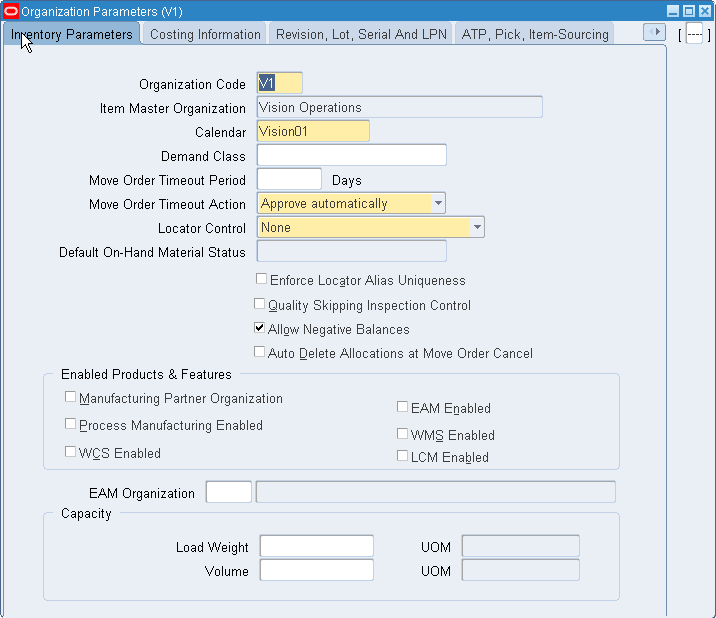
-
Select the Inventory Parameters tab.
-
Enter an organization code. See Creating an Organization, Oracle Hurman Resource Management User's Guide.
-
Select an Item Master organization.
You create items in the item master organization and assign them to other organization within your operating unit.
-
Select a workday calendar. This is required when Oracle Master Scheduling/MRP and Oracle Supply Chain Planning is installed. See Creating a Workday Calendar, Oracle Bills of Material User's Guide.
-
Optionally, select a demand class.
Demand classes segregate scheduled demand and production into groups, and allow you to track and consume those groups independently. Oracle Master Scheduling/MRP and Oracle Supply Chain Planning uses this demand class during forecast consumption, and shipment and production relief. See Demand Classes, Oracle Master Scheduling / MRP and Oracle Supply Chain Planning User's Guide.
-
In the Move Order Time-out Period field, enter the maximum number of days a move order requisition can wait for approval.
The workflow approval process sends a notification to the item planner when a move order requisition requires approval. After the first time-out period, if the recipient has not approved or rejected the order, the system sends a reminder notice. After the second time-out period, the system automatically rejects or approves the order depending on whether you select Approve automatically or Reject automatically in the Move Order Time-out Action field.
-
Select a Move Order Time-out Action:
Approve automatically: After the second time-out period, the system automatically approves move order requisitions. Select this option and set the Move Order Time-out Period to 0 if you want to bypass the move order approval process and automatically approve move order requisitions.
Reject automatically: After the second time-out period, the system automatically rejects move order requisitions.
-
Select a locator control option:
None: Inventory transactions within this organization do not require locator information.
Prespecified only: Inventory transactions within this organization require a valid, predefined locator for each item.
Dynamic entry allowed: Inventory transactions within this organization require a locator for each item. You can choose a valid, predefined locator, or define a locator dynamically at the time of transaction.
Determined at subinventory level: Inventory transactions use locator control information you define at the subinventory level.
-
Select a Default On-hand Material Status tracking option. This step is optional.
Important: You cannot update this field for existing organizations. To enable this field, you must submit the Activate Onhand Level Material Status Tracking concurrent program.
-
Indicate whether to allow quality skipping for inspections.
-
Indicate whether locator aliases must be unique across the organization.
-
Indicate whether to allow negative balances.
This parameter determines if inventory transactions can drive the inventory balance of an item negative.
Important: If insufficient quantity of on hand material exists in a supply subinventory to satisfy backflush demand, Oracle Work in Process forces the supply subinventory balance negative, and ignores this option setting.
-
Indicate whether auto delete Allocations are enabled. If you select this check box, when you delete a source order, or delete or cancel the order line, the system automatically deletes the associated move order allocations. If you do not select the check box, when you delete a source order, or delete or cancel the order line, then the system does not delete the associated allocations lines. You must manually delete the move order line allocations. If you choose not to delete these lines, the system transacts these lines as subinventory transfers, and does not consider the lines as over picks.
Note: You can enable auto delete allocations only if you do not enable Warehouse Management for the organization. In a Warehouse Management organization, the system automatically deletes move order allocations or tasks unless a user starts work on the task.
-
Indicate whether this is a manufacturing partner organization. This parameter enables you to use Chargeable Subcontracting. Chargeable Subcontracting is support only for Japan, Taiwan, and Korea. . If you enable this parameter, then you must set the Transfer to GL parameter to No. This parameter indicates if an original equipment manufacturer is a manufacturing partner.
-
Select the Process Manufacturing enabled check box if the organization is a Process Manufacturing organization. If the organization is a process manufacturing organization you can use process applications such as Process Execution, Process Quality, and Process Costing.
-
Check the Warehouse Control System (WCS) to enable the Warehouse Control System. The Warehouse Control System provides a bridge between Warehouse Management and the control level for device automation and integration, and the coordination of task execution.
Note: You can only enable WCS for Warehouse Management organizations.
-
Indicate whether this organization is enabled for the Oracle Enterprise Asset Management (eAM) application. For more information about enabling the organization for eAM, see Oracle Enterprise Asset Management Implementation Guide, Enabling Organizations for Enterprise Asset Management.
-
Indicate whether this organization is an Oracle Warehouse Management enabled organization. You can use Warehouse Management features such as LPNs, task management, warehouse execution rules, and cost groups in this organization. See Warehouse Setup, Oracle Warehouse Management User's Guide.
You must enable locator control in order to enable Warehouse Management. After you process transactions within the organization, you cannot change the value of this parameter.
-
Enter a total load weight and unit of measure for this organization.
-
Enter a total volume and unit of measure for this organization.
To continue defining organization parameters
Select the Costing Information tabbed region. See Defining Costing Information.
To set up security parameters for the Status Update Details window (Material Workbench)
The system administrator can restrict access to fields and status levels on the Status Update Details window by setting security parameters on the Form Functions window.
Note: The Status Update Details window is accessed from the Material Workbench.
-
Navigate to the Form Functions window.
-
On the Description tab, in the Function field, query the function name INV_INVMATWB (User Function Name = Material Workbench).
-
Select the Form tab to view the parameters.
-
Set the value of the following parameters from No (N) to Yes (Y) to restrict access to the fields/status levels on the Status Update Details window. If the value is Yes, then the corresponding user cannot update the material status in the Material Workbench window (at the node level). You can set values for the following parameters to restrict the user from updating the status update at the corresponding node level:
-
NO_SUB = "Y": Restricts access to the Subinventory Status region.
-
NO_LOC = "Y": Restricts access to the Locator Status region.
-
NO_LOT = "Y": Restricts access to the Lot Status region.
-
NO_ONHAND = "Y": Restricts access to the On-hand Status region.
-
Related Topics
Defining Revision, Lot, Serial, LPN Parameters
Defining ATP, Pick, Item-Sourcing Parameters
Defining Inter-Organization Information
Defining Other Account Parameters
Locator Alias, Oracle Warehouse Management User's Guide
Defining Costing Information
To define costing parameters and accounts
-
Navigate to the Organization Parameters window.
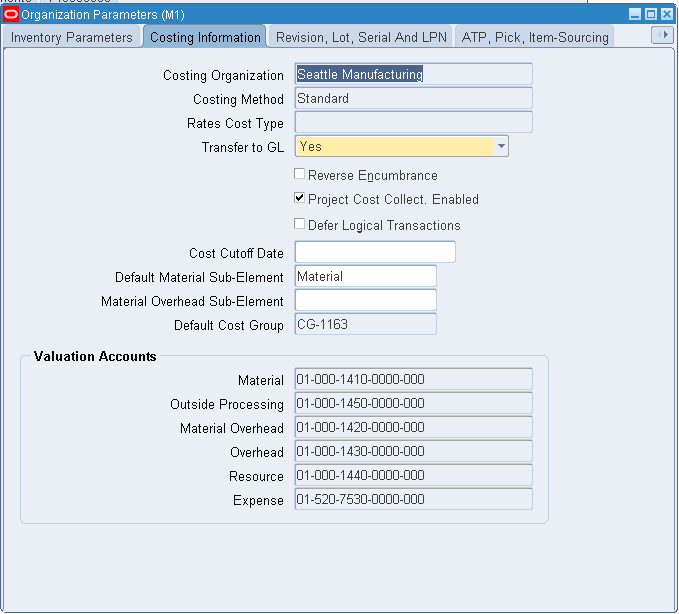
-
Select the Costing Information tabbed region.
Note: Note this tab applies only to discrete organizations.
The costing organization that controls the costs in your current organization and the costing method are displayed. You cannot make changes to these fields.
See: Cost Structure, Oracle Cost Management User's Guide, Standard Costing, Oracle Cost Management User's Guide, and Average Costing, Oracle Cost Management User's Guide.
-
When the Costing Method is Average, you can enter the Average Rates Cost Type. See: Defining Cost Types, Oracle Cost Management User's Guide.
-
Indicate whether all transactions are posted in detail to the general ledger.
Caution: Transferring detail transaction distributions to the general ledger increases general ledger posting times due to the number of records created.
-
Indicate whether to reverse encumbrance entry upon receipt in inventory.
You normally select this option if you use encumbrances with Oracle Purchasing. See: Overview of Receipt Accounting, Oracle Purchasing User's Guide.
-
Indicate whether subinventories can be associated with a given project and task.
If the Project Cost Collection Enabled check box is selected, and the Enable Project References check box, located in the Project Manufacturing Parameters, is also selected, the cost collector process can transfer costs to project accounting.
See, Project Manufacturing Parameters, Oracle Project Manufacturing User's Guide and Project Manufacturing Costing, Oracle Project Manufacturing User's Guide for more information.
-
Indicate whether to defer logical transactions.
-
Optionally, enter a Cost Cutoff Date.
If you leave this field blank, all available transactions will be costed, as usual. If you enter a date, all transactions prior to this date will be costed. All transactions on or later than this date will not be costed. For inter-organization transfers, a standard costing, receiving organization will not cost a receipt if the sending organization did not already cost the transaction.
The default time is the first instant of the date. You can optionally choose another time.
The standard cost update process can be performed on the cost cutoff date. You can restart cost processing by changing the cutoff date to blank, or a future date.
-
For standard costing, select a material sub-element that this organization uses as a default when you define item costs. For average costing, the default material sub-element you select can be used for cost collection when Project Cost Collection Enabled is set.
Important: Since a material sub-element is organization specific you must define the organization first, then the sub-element, then the organization parameters. When you first define your parameters you can leave this field blank, save your work, then return to this field later to specify a default material sub-element.
-
Optionally, select a Default Material Overhead Sub-Element from the list of values. During the Supply Chain Rollup process, when costs are merged from another organization, markup and shipping costs will use this value.
The supply chain cost rollup will complete successfully, regardless of whether this field is populated. If the Cost Rollup identifies an organization with a default material overhead sub-element not set up, a corresponding warning message will be printed in the log file.
-
Indicate the default cost group for the organization. This will default into the Default Cost Group field for each subinventory. If the WMS cost group rules engine fails to find a cost group, this cost group will be used. See: Overview of the WMS Rules Engine, Oracle Warehouse Management User's Guide. This feature is available if you have Oracle Warehouse Management installed, and you are working with a WMS enabled organization. See: Defining Default Inventory Parameters.
-
Define default Valuation Account details. See: Valuation Accounts and Defining Subinventories.
To continue defining organization parameters
-
Select the Revision, Lot, Serial, LPN tabbed region. See: Defining Revision, Lot, Serial, LPN Parameters.
Related Topics
Defining Default Inventory Parameters
Defining ATP, Pick, Item-Sourcing Parameters
Defining Inter-Organization Information
Defining Other Account Parameters
Valuation Accounts
You choose a default valuation account when you define organization parameters. Under standard costing, these accounts are defaulted when you define subinventories and can be overridden. Under average costing, these accounts (except for Expense) are used for subinventory transactions and cannot be updated. For a detailed discussion of cost elements see: Cost Structure, Oracle Cost Management User's Guide.
| Material | An asset account that tracks material cost. For average costing, this account holds your inventory and intransit values. Once you perform transactions, you cannot change this account. |
| Material Overhead | An asset account that tracks material overhead cost. |
| Resource | An asset account that tracks resource cost. |
| Overhead | An asset account that tracks resource and outside processing overheads. |
| Outside processing | An asset account that tracks outside processing cost. |
| Expense | The expense account used when tracking a non-asset item. |
Other Accounts
| Sales | The profit and loss (income statement) account that tracks the default revenue account. |
| Cost of Goods Sold | The profit and loss (income statement) account that tracks the default cost of goods sold account. |
| Purchase Price Variance | The variance account used to record differences between purchase order price and standard cost. This account is not used with the average cost method. |
| Inventory A/P Accrual | The liability account that represents all inventory purchase order receipts not matched in Accounts Payable, such as the uninvoiced receipts account. |
| Invoice Price Variance | The variance account used to record differences between purchase order price and invoice price. This account is used by Accounts Payable to record invoice price variance. |
| Encumbrance | An expense account used to recognize the reservation of funds when a purchase order is approved. |
| Project Clearance Account | When performing miscellaneous issues to capital projects, the project clearance account is used to post the distributions. |
| Average Cost Variance | Under average costing with negative quantity balances, this account represents the inventory valuation error caused by issuing your inventory before your receipts. |
Note: For standard costing, only the Purchase Price Variance, Inventory A/P Accrual, Invoice Price Variance, Expense, Sales and Cost of Goods Sold accounts are required. The other accounts are used as defaults to speed your set up.
Note: For average costing, only the Material, Average Cost Variance, Inventory A/P Accrual, Invoice Price Variance, Expense, Sales and Cost of Goods Sold accounts are required. The other accounts are used as defaults or are not required.
Defining Other Account Parameters.
Subinventory General Ledger Account Fields.
Defining Revision, Lot, Serial, and LPN Parameters
-
Navigate to the Organization Parameters window.

-
Select the Revision, Lot, Serial And LPN tab.
-
Enter a starting revision to be the default for each new item.
To define Lot Control parameters
-
Select the Revision, Lot, Serial and LPN tab.
-
Select an option for lot number uniqueness.
Across items: Enforce unique lot numbers for items across all organizations.
None: Unique lot numbers are not required.
-
Select an option for lot number generation.
User-defined: You can define a lot number for an item when you receive it.
At organization level: The system uses values you enter in the Prefix, Zero Pad Suffix, and Total Length fields to automatically generate a lot number for an item when you receive it.
At item level: The system uses the starting lot number prefix and the starting lot number you define in the item master to automatically generate a lot number for an item when you receive it.
-
Indicate whether to add zeroes to right-justify the numeric portion of lot numbers (Zero Pad Suffix).
-
Optionally, select an alphanumeric lot number prefix to use for system-generated lot numbers when you generate lot numbers at the organization level.
-
Optionally, define the maximum length for lot numbers.
If you use Oracle Work in Process and you set the WIP parameter to default the lot number based on inventory rules, then WIP validates the length of the lot number against the length that you enter in this field.
-
Indicate how to generate child lots if you lot control at the organization level. The available choices are:
-
Parent: The system bases the child lot numbers on the same sequence as the lot number. For example, if a parent lot is P1, then the child lot is P2.
-
Parent + Child: The parent lot acts as a prefix, and the system adds the next available number to form the child lot. For example if the parent lot is P1, then the child lot is P1-1.
-
-
Indicate whether to add zeroes to right-justify the numeric portion of lot numbers (Zero Pad Suffix).
-
Enter an alphanumeric prefix if you set the child lot generation to Parent + Child.
-
Enter the total amount of characters for the child lot. This includes the prefix if applicable.
-
Select Format Validation to ensure that manually entered lots conform to the predetermined naming convention.
-
Select Copy Lot Attributes to ensure the child lots inherit the parent lot information.
-
Select the desired value for Auto Create Lot UOM Conversion. If set to Yes or User Confirmation, then the system automatically creates lot-specific unit of measure conversions. The system bases the conversion on lot quantities that you receive in the transactional UOM, and creates a conversion between the transactional UOM and the secondary UOM. The system creates a lot conversion only if the item is under dual unit of measure control and the lot conversion is different from the item conversion. For example, a conversion would be created only if the user changes the secondary quantity (or the primary quantity without changing the secondary quantity) so that the conversion between primary and secondary is different from the item level conversion. The available values are:
-
Yes
-
No
-
User Confirmation
-
Null
Note: If you enable this parameter, then the system automatically creates lot level UOM conversions for lots that are created in Inventory and Process Manufacturing. It does not automatically create lot-level UOM conversions for lots that are created in Work in Process.
-
-
Select the value for Allow Different Material Status to control what happens if material statuses differ when you perform transactions (differences in material status of non-lot controlled items are included as well). The values are:
-
Yes: You can transfer out of, receive into, or produce material into an existing status and the new quantity inherits the status of the existing material.
-
No: You cannot transfer out of, receive into, or produce material into an existing status.
-
With Exception: You can transfer out of, receive into, or produce material into an existing status only if the on-hand balance of the destination organization is zero.
Note: This feature is extended to Intra-Org Transactions like subinventory transfer, and staging transfer.
-
To define Serial Control parameters:
-
Select the Revision, Lot, Serial And LPN tab.
-
Select an option for serial number uniqueness.
Within organization: Enforce unique serial numbers within the current organization.
Within inventory items: Enforce unique serial numbers for inventory items.
Across organizations: Enforce unique serial numbers throughout all organizations.
-
Select an option for serial number generation.
At organization level: Define the starting prefix and serial number information for items using the information you enter in the following fields of this window.
At item level: Define the starting serial number prefix and the starting serial number when you define the item.
-
Optionally, select an alphanumeric serial number prefix to use for system-generated serial numbers when generation is at the organization level.
-
Optionally, enter a starting serial number to use for system-generated serial numbers.
If serial number generation is at the organization level, you must enter a starting serial number.
-
Indicate whether the system suggests serial numbers as part of the move order line allocating process. If you do not select this option, you must manually enter the serial numbers in order to transact the move order.
To define LPN Generating Options
If you have Oracle Warehouse Management installed, and you are working with a Warehouse Management enabled organization, you can define LPN Generating Options. LPNs must be unique across organizations. Setting the parameters on this tab enables the system to generate LPNs on demand, or through a concurrent request. As long as the number is unique, Oracle Warehouse Management also enables you to generate your own LPNs. You can also generate LPNs using the 18-digit Serialized Shipping Container Code (SSCC-18) standard. The SSCC-18 number ensures a unique LPN number for shipping containers across the supply chain. This number is required to generate a UCC-128 shipping label. SSCC-18 or the license plate number appearing on UCC-128 label is also required on outbound ASNs that the system transmits customers. Consequently, it is important that LPNs are generated using SSCC-18 standard within Oracle Warehouse Management. Oracle Shipping Execution refers to this LPN in the outbound ASN. The data structure for the 18-digit number consists of the following:
| Extension Digit | UCC Company Prefix | Container Serial Number | Check Digit |
|---|---|---|---|
| 0 | 123556 | 3047 | 4 |
| Extension Digit No Intelligence | Company Prefix | Serial Number | Mod 10 Check digit |
LPN Generation Parameters can be setup to auto-generate LPNs confirming to SSCC-18 standards. In order to do so, the UCC Company Prefix and Extension Digit is defined as the LPN Prefix. The LPN length is entered as 18. The serial number is the starting serial number for LPN generation. This system increments this number when it generates LPNs. This number will be padded by leading ‘0’ to generate LPN with the desired length. As per UCC standards, the combined length of UCC company prefix and container serial number cannot exceed 16 digits. In Oracle Warehouse Management, LPN generation setup can autocreate LPNs using SSCC-18 standards.
| Total Length | LPN Prefix | Serial Number | UCC-128 Suffix Flag |
|---|---|---|---|
| 18 | 123556 | 3047 | Yes |
The previous table auto-generates LPNs confirming to SSCC-18 standards as follows:
-
012355600000030474
-
012355600000030481
-
012355600000030498
-
012355600000030504
Often times UCC Application Identifier (AI) for LPN 00 is also added in the LPN prefix and the LPN number with AI is transmitted in EDI messages. In such a case, the LPN length is entered as 20 and the Application Identifier 00 is added to the LPN Prefix. The following example illustrates this type of scenario:
| Total Length | LPN Prefix | Serial Number | UCC-128 Suffix Flag |
|---|---|---|---|
| 20 | 123556 | 3047 | Yes |
In the previous table, the system auto-generates LPNs that confirm to SSCC-18 standards as follows:
-
00012355600000030474
-
00012355600000030481
-
00012355600000030498
-
00012355600000030504
Note: The Modulo-10 check digit remains the same even when Application Identifier 00 is included in the LPN generation prefix.
To generate LPNs:
-
Enter the prefix to append to every LPN generated in this organization.
-
Enter the suffix to append to every LPN generated in this organization.
-
Enter the starting number from which LPNs the system generates LPNs.
-
Indicate if a UCC-128 suffix is appended to the LPN.
To continue defining organization parameters
-
Select the ATP, Pick, Item-Sourcing tab. See: Defining ATP, Pick, Item-Sourcing Parameters.
Related Topics
Defining Default Inventory Parameters
Defining Inter-Organization Information
Defining Other Account Parameters
Setting Up Serial Number Control
Defining ATP, Pick, Item-Sourcing Parameters
To define optional ATP and Picking defaults
-
Navigate to the Organization Parameters window.
-
Select the ATP, Pick, Item-Sourcing tab.
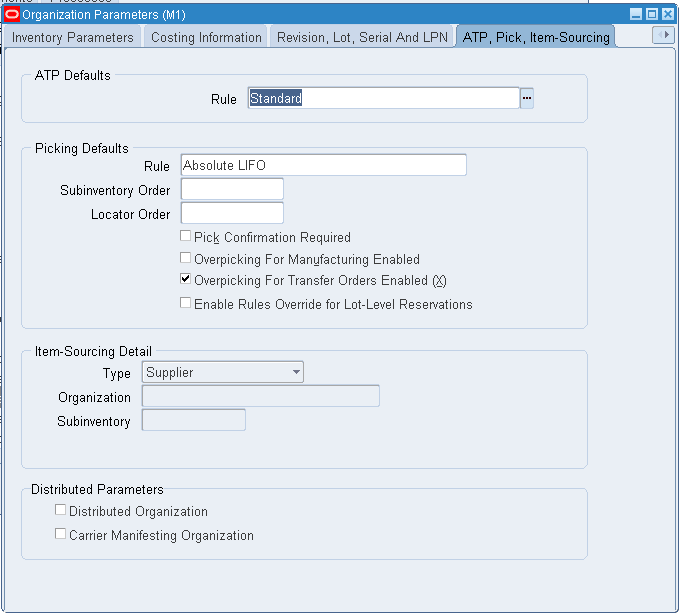
-
ATP rules define the options the system uses to calculate the available to promise quantity of an item. If you are using Oracle Order Management, the default is the ATP rule for the Master organization.
-
Select a default picking rule.
Picking rules define the priority that Order Management functions use to pick items.
Important: This rule will not be employed in a WMS enabled organization. The WMS picking rules will be used. See Defining Default Inventory Parameters.
-
Enter a default subinventory picking order.
This value indicates the priority with which you pick items from a subinventory, relative to another subinventory, in which a given item resides. The value that you enter appears as the default when you define a subinventory.
-
Enter a default locator picking order.
This value indicates the priority with which you pick items from a locator, relative to another locator, where a given item resides. The value you that enter appears as the default when you define a locator.
Important: A picking order of 1 means that order management functions pick items from that subinventory or locator before others with a higher number (such as 2, 3, and so on).
-
Select the Pick Confirmation Required check box if you want your pickers to manually pick confirm. If you do not select the check box, then pick confirmation occurs automatically.
Important: For Oracle Warehouse Management to dispatch picking tasks to users, this check box should be deselected in Warehouse Management enabled organizations.
-
Select Overpicking for Manufacturing Enabled to allow operators to over pick components and ingredients for WIP jobs and process batches.
-
Select Overpicking for Transfer Orders Enabled to allow over allocation for move orders.
-
Select Enable Rules Override for Lot-Level Reservation to allow a reservation to take priority over an allocation, if the reservation is fully detailed. This means that if an order has a reservation that includes all necessary details such as subinventory, locator, and lot, then the system uses this reservation instead of picking rules to create the allocation.
To define optional Item Sourcing defaults
-
Select the ATP, Pick, Item-Sourcing tab region.
-
Select a source type for item replenishment. The source types are as follows:
Inventory: Replenish items internally from another subinventory in the same organization or another organization.
Supplier: Replenish items externally, from a supplier you specify in Oracle Purchasing.
None: No default source for item replenishment.
-
Select the organization used to replenish items.
You must enter a value in this field if you selected Inventory in the Type field.
-
Select the subinventory used to replenish items.
You must enter a value in this field if you selected your current organization in the Organization field. You cannot enter a value in this field if you selected Supplier in the Type field.
To continue defining organization parameters
-
Select the Inter-Organization Information tabbed region. See: Defining Inter-Organization Information.
Related Topics
Defining Default Inventory Parameters
Defining Revision, Lot, Serial, LPN Parameters
Defining Other Account Parameters
Defining Inter-Organization Information
To define a default inter-organization transfer charge
-
Navigate to the Organization Parameters window.
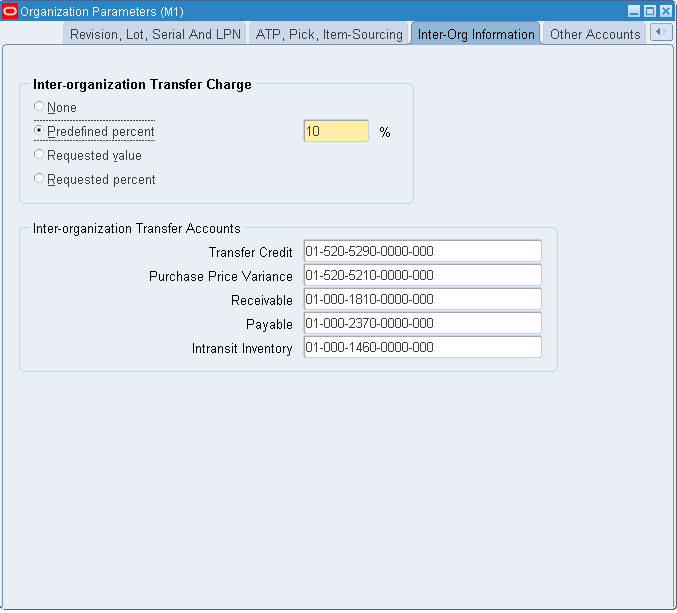
-
Select the Inter-Org Information tabbed region.
-
Select an Inter-Organization Transfer Charge option.
None: Do not add transfer charges to a material transfer between organizations.
Predefined percent: Automatically add a predefined percent of the transaction value when you perform the inter-organization transfer.
Requested value: Enter the discrete value to add when you perform the inter-organization transfer.
Requested percent: Enter the discrete percentage of the transfer value to add when you perform the inter-organization transfer.
-
If you selected Predefined percent in the Inter-Organization Transfer Charge field, enter a percentage value to add to a material transfer.
To define optional default inter-organization transfer accounts
-
Select the Inter-Org Information tabbed region.
-
Enter default inter-organization cost accounts. These accounts are defaulted when you set up shipping information in the Inter-Organization Shipping Networks window. See: Inter-Organization Transfer Accounts.
To continue defining organization parameters
-
Select the Other Accounts tabbed region. See: Defining Other Account Parameters.
Related Topics
Defining Default Inventory Parameters
Defining Revision, Lot, Serial, LPN Parameters
Defining ATP, Pick, Item-Sourcing Parameters
Inter-Organization Transfer Accounts
You define default inter-organization transfer accounts in the Organization Parameters window. These accounts are defaulted when you set up shipping information in the Inter-Organization Shipping Networks window.
Note: When you set up accounts the primary ledger restricts the legal entity and operating unit.
The default general ledger account used to collect transfer charges when this organization is the shipping organization. This is usually an expense account.
The default general ledger account used to collect the purchase price variance for inter-organization receipts into standard cost organizations. This is usually an expense account.
The default general ledger account used as an inter-organization clearing account when this organization is the receiving organization. This is usually a liability account.
The default general ledger account used as an inter-organization clearing account when this organization is the shipping organization. This is usually an asset account.
The default general ledger account used to hold intransit inventory value. This is usually an asset account. For average cost organizations, this account is the default material account.
Related Topics
Defining Inter-Organization Information
Defining Other Account Parameters
To define Receiving Account information:
-
Navigate to the Organization Parameters window.
Note: When you set up accounts the primary ledger restricts the legal entity and operating unit.
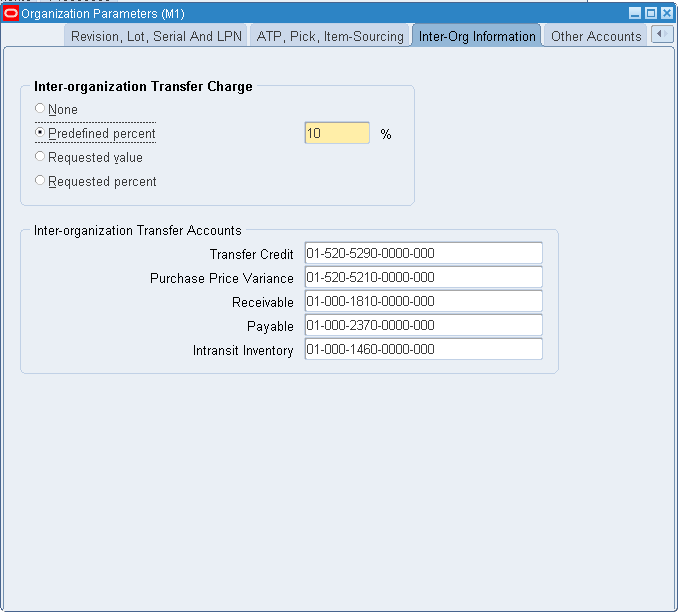
-
Select the Other Accounts tabbed region.
-
Enter a general ledger account to accumulate Purchase Price Variance for this organization.
This is the variance that you record at the time you receive an item in inventory, and is the difference between the purchase order cost and an item's standard cost. Purchase price variance is calculated as:
PPV = (PO unit price - standard unit cost) quantity received
Purchase price variance is not used for average costing.
-
Enter a general ledger account to accumulate Invoice Price Variance for this organization. This is usually an expense account.
Invoice price variance is the difference between the purchase order price for an inventory item and the actual invoice price multiplied by the quantity invoiced. Oracle Inventory passes this account to Oracle Purchasing when the requisition or purchase order is created. When Oracle Payables matches and approves the invoice, Oracle Payables uses the invoice price variance account from the purchase order to record invoice price variance entries. In addition, if you have exchange rate variances, Oracle Payables also records invoice price variance for exchange rate gains and losses.
-
Enter a general ledger account to accumulate Inventory Accounts Payable Accrual for this organization.
This is the account used by Oracle Purchasing to accrue your payable liabilities when you receive your items. This account represents your uninvoiced receipts and is usually part of your Accounts Payable Liabilities in the balance sheet. Oracle Payables relieves this account when the invoice is matched and approved.
-
Enter a default general ledger account to accumulate Encumbrance for this organization. This is the default account when you define your subinventories.
To define Profit and Loss Account information
-
Select the Other Accounts tabbed region.
-
Enter a default Sales revenue account.
When you define your items, this account is defaulted to the item's sales account in the Invoicing attribute group.
-
Enter a default Cost of Goods Sold account.
When you define your items, this account is defaulted to the item's cost of goods sold account in the Costing attribute group.
-
Enter the deferred cogs account. The Deferred COGS account holds the costs until Receivables recognizes the revenue.
To define Average Cost Account information:
-
Select the Other Accounts tabbed region.
-
Under average costing with negative quantity balances, this account represents the inventory valuation error caused by issuing your inventory before processing your receipts. This account is required only when using average costing. See: Average Costing, Oracle Cost Management User's Guide and Cost Structure, Oracle Cost Management User's Guide.
-
Save your work.
Defining Warehouse Parameters
When Oracle Warehouse Management is enabled for your organization, the Organization Parameters window displays the Warehouse tab and Warehouse Task Management tab where you can define warehouse parameters. For more information, see the Oracle Warehouse Management Implementation Guide, Setting Up a Warehouse Organization, Oracle Warehouse Management Implementation Guide.
Defining Subinventories
Subinventories are unique physical or logical separations of material inventory, such as raw inventory, finished goods, or defective material. All material within an organization is held in a subinventory therefore, you must define at least one subinventory. The Subinventories window consists of the following tabs where you can define parameters for the selected subinventory:
-
Warehouse tab (available only if Oracle Warehouse Management is enabled for the organization)
To define subinventory information (Main tab)
The following section describes how to define subinventory attributes on the header and Main tab of the Subinventories window.
-
Navigate to the Subinventories window.

-
This table describes the main fields in the header region of the Subinventory window.
Field Description Status Indicate the material status of this subinventory. The material status controls the enabled transactions for all material in this subinventory. The status is not overridden by the status of any locator, lot or serial, within this subinventory. The material status also determines whether reservations are allowed for this subinventory, whether the material in the subinventory is included in ATP, or whether the material is nettable. The Status Attributes region indicates if the ATPable, reservable, and nettable attributes apply to the material status that you select for the subinventory. You cannot make changes to this region. For more information, see Setting Up Material Status. Default Cost Group Select the default cost group for this subinventory. If the cost group assignment rules fail to identify a cost group for newly received material, this cost group will be assigned. This cost group will remain with the material, even through subinventory transfers, until you perform a cost group change transaction. Note: This feature is available if you have Oracle Warehouse Management installed, and you are working with a Warehouse Management enabled organization. See Defining Default Inventory Parameters.
Type Select a subinventory type: -
Storage: Designates the subinventory as a Storage subinventory.
-
Receiving: Designates the subinventory as a receiving subinventory, and links it to a receiving location. This subinventory type is used only for receiving material. Material in this type of subinventory cannot be on-hand, or reserved.
-
Null: No subinventory designation.
-
-
This table describes the fields located in the Parameters region and Lead Times region of the Subinventories window.
Field Description Quantity Tracked Indicate whether each transaction for this subinventory updates the quantity on hand for the subinventory. If deselected, on-hand balances are not maintained and you cannot select or update the Asset Subinventory option. Note: You can update this value only if there is no on-hand quantity, no pending transaction, or no uncosted transaction for the subinventory.
Asset Subinventory Select this option to maintain the value of this subinventory on the balance sheet. Note: You can update this value only if there is no on-hand quantity for the subinventory.
Depreciable Select whether this subinventory is depreciable. See: Using Network Logistics, Oracle Network Logistics Concepts and Procedures. Enable PAR Level Planning Indicates if Periodic Automatic Replenishment (PAR) is enabled. If selected, min-max planning cannot be performed for this subinventory. Enable Locator Alias Indicate whether you can create locator aliases for locators within this subinventory. If you enable this parameter, you must create locator aliases for locators within this subinventory. Enforce Alias Uniqueness Indicate if the locator aliases are unique across the subinventory. Note: You can also set this parameter at the organization level. If set at the organization level, and you click Enable Locator Alias, you cannot update this parameter.
Locator Control Select a type of locator control: -
None: Inventory transactions within this subinventory do not require locator information.
-
Prespecified: Inventory transactions within this subinventory require you to enter a valid predefined locator for each item.
-
Dynamic entry: Inventory transactions within this subinventory require you to enter a locator for each item. You may choose a valid predefined locator, or define a locator dynamically at the time of transaction.
-
Item level: Inventory transactions use locator control information that you define at the item level.
Important: You can select an option only if you selected locator control as Determined at subinventory level in the Locator Control field in the Organization Parameters window. You can update this option only if there is no on-hand quantity for the subinventory.
Default Locator Status Indicates the default locator status of the locators in this subinventory. Picking Order Enter a picking order value for use by Oracle Warehouse Management to sequence picking tasks.
This value indicates the priority with which you pick items from this subinventory, relative to another subinventory, where a given item resides. If you have Oracle Warehouse Management installed, this field determines the picking path through the warehouse and not the order in which material is allocated for a sales order.Important: A picking order of 1 means that order management pick items from that subinventory or locator before others with a higher number (such as 2).
Dropping Order Enter a dropping order value for use by Oracle Warehouse Management to sequence material drops. Inactive On Optionally, enter an inactive date on which the subinventory becomes inactive. As of this date, you can no longer assign the subinventory to any function within Oracle Applications. In addition, you cannot receive items into or issue items from the subinventory. The subinventory remains inactive until you change the inactive date to a future date, or remove the inactive date. Important: Before you disable a subinventory, you must make certain that no open jobs or schedules in Oracle Work in Process use it as the backflush subinventory and that no active bills in Oracle Bills of Material use it as the supply subinventory for pull requirements.
Location Enter a location for the subinventory. If the Subinventory type is Receiving, this field is mandatory. See: Using Network Logistics, Oracle Network Logistics Concepts and Procedures. See: Oracle Spares Management in CRM, Oracle Spares Management Concepts and Procedures. Picking UOM Select the picking unit of measure used to store material in this subinventory. It is used by the WMS rules engine to divide picks across subinventories in the warehouse. See Overview of the WMS Rules Engine, Oracle Warehouse Management User's Guide. You must also enter a valid pick UOM if you want to print labels by case or pallet. The number of labels printed will depend on the Pick UOM. See Labeling Overview, Oracle Warehouse Management User's Guide These features are available if you have Oracle Warehouse Management installed, and you are working with a Oracle Warehouse Management-enabled organization. See: Defining Default Inventory Parameters. Default Replenishment Count Type Select the appropriate Default Replenishment Count Type. This field defaults the default count type on the Replenishment Lines window. It does not affect existing Default Count Type headers. Lead Times region (Pre-Processing, Processing, Post-Processing) Optionally, enter pre-processing, processing, and post-processing lead times for items in this subinventory. These lead times are used when you use min-max planning at the subinventory level. -
-
Select the sourcing criteria:
-
Type: Select a source type for item replenishment.
-
Inventory: Replenish items internally, from another organization.
-
Supplier: Replenish items externally, from a supplier you specify in Oracle Purchasing.
-
Subinventory: Replenish items internally, from another subinventory in the same inventory organization. You must enter a value in this field if you entered Inventory in the Type field. The organization you select must have a shipping network defined.
-
-
Organization: Select the organization used to replenish items in this subinventory. You must enter a value in this field if you entered your current organization in the Organization field.
-
Subinventory: Select the subinventory for replenishing items.
-
To define accounts (Accounts tab)
-
Enter the general ledger accounts. See: Subinventory General Ledger Account Fields.
The default accounts are those defined for the organization in the Organization Parameters window:
-
Average costing: For average costing, you may enter the valuation accounts, but they are not used. Average costing uses only the Expense and Encumbrance accounts.
-
Standard costing: For standard costing (and Oracle Bills of Material is installed), all asset accounts are required. If you use standard costing, and Oracle Bills of Material is not installed, you are only required to enter the Material and Material Overhead accounts.
-
-
Save your work.
To define warehouse parameters (Warehouse tab)
The Warehouse tab is available only if Oracle Warehouse Management (WMS) is installed and enabled for your organization. (WMS is enabled when the WMS Enabled check box is selected in the Organization Parameters window.)
-
Select the Warehouse tab.
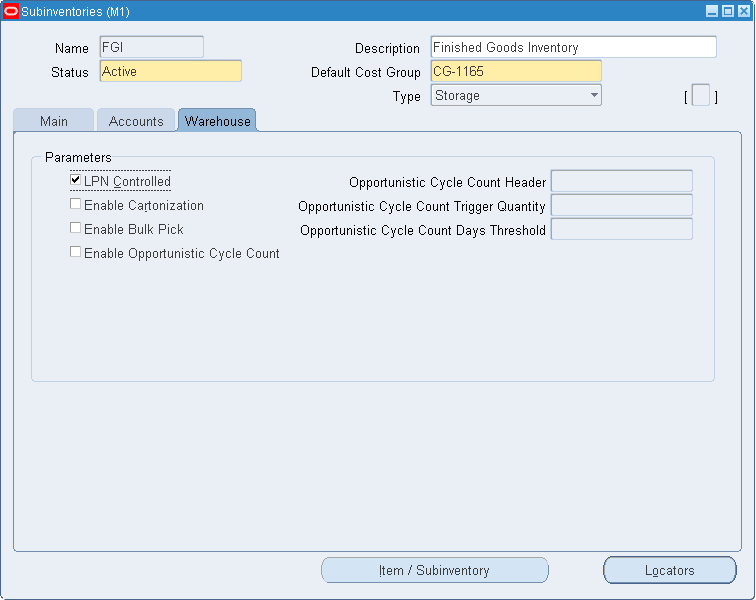
-
This table describes the fields located on the Warehouse tab of the Subinventories window.
Field Description LPN Controlled Select this option to enable LPN controlled material in the subinventory. Enable Cartonization Select this option to enable cartonization for this subinventory. Enable Bulk Pick Select this option to enable bulk pick for this subinventory. Enable Opportunistic Cycle Count Select this option to enable opportunistic cycle count for the subinventory. Opportunistic Cycle Count Header Select the default cycle count header. Opportunistic Cycle Count Trigger Quantity Defines the quantity at which the cycle count is triggered for the locator. (This is a required field when controlled at the subinventory level.)
If using zero cycle counting at the subinventory level, then the pick UOM of the subinventory serves as the quantity trigger. If not specified, use the primary UOM.Opportunistic Cycle Count Days Threshold Defines the number of days that can occur between a cycle count.
(Required field if the Enable Opportunistic Cycle Count check box is selected for the subinventory.)
Related Topics
Item/Subinventory button: Assigning Items to a Subinventory
Locators button: Defining Stock Locators
Overview of Inventory Structure
Customizing the Presentation of Data in a Folder, Oracle Applications User's Guide
Locator Alias, Oracle Warehouse Management User's Guide
Subinventory Transfers of Depreciable Items, Oracle Network Logistics Concepts and Procedures User's Guide
Subinventory General Ledger Account Fields
Material
Enter a general ledger account to accumulate material costs for items received into this subinventory. This is usually an asset account used for the value of goods stored in this subinventory. For asset items, you use this account as a default when you generate purchase requisitions from MRP, min–max organization level planning, or reorder point planning. However, when you receive the purchase order, you use the appropriate valuation or expense account.
Outside Processing
Enter a general ledger account to accumulate outside processing costs for this subinventory. This is usually an asset account. Oracle Work in Process charges this account at standard cost when you receive items for a job or schedule in Oracle Purchasing. Oracle Work in Process relieves this account at standard cost when you issue components to a job or schedule.
Material Overhead
Enter a general ledger account to accumulate material overhead or burden costs for this subinventory. This is usually an asset account.
Overhead
Enter a general ledger account to accumulate resource or department overhead costs for this subinventory. This is usually an asset account. Oracle Work in Process charges this account at standard cost when you complete assemblies from a job or schedule. Oracle Work in Process relieves this account at standard when you issue components to a job or schedule.
Resource
Enter a general ledger account to accumulate resource costs for this subinventory. This is usually an asset account. Oracle Work in Process charges this account at standard cost when you complete assemblies from a job or schedule. Oracle Work in Process relieves this account at standard cost when you issue components to a job or schedule.
Expense
Enter a general ledger account to accumulate expenses for this subinventory. For expense subinventories, this account is charged when you receive any item. For asset subinventories, this account is charged when you receive an expense item.
Encumbrance
Oracle Purchasing Only
Enter a general ledger account to hold the value of encumbrances against items in this subinventory. This account is used for purchase order receipts and returns.
Related Topics
Defining Stock Locators
You use locators to identify physical areas where you store inventory items. Item quantities can be tracked by locator. Items can also be restricted to specific locators.
To define required information for a locator
-
Navigate to the Stock Locators window.
-
Select New to display the Stock Locators window ready to define a new locator.
You can also enter search criteria to find existing locators.
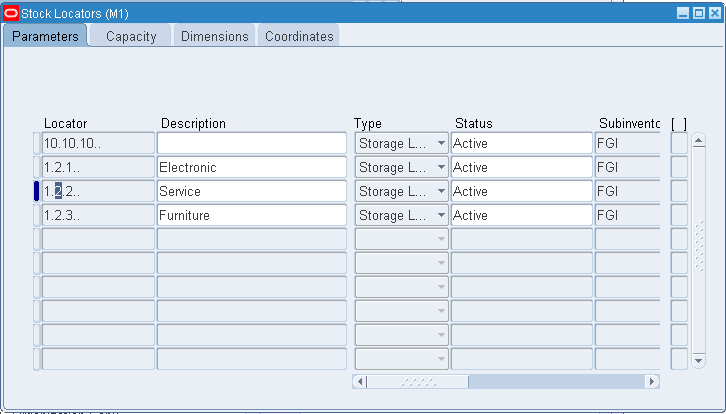
-
Select the Parameters tabbed region.
-
Enter a locator and a description. The locator must be unique across an organization.
-
Indicate the locator type. Available choices are: Dock Door, Staging Lane, Storage Locator, Consolidation Locator, Packing Station, Receiving, Inspection Station. Dock doors are used in Oracle Warehouse Management environments only. See Setting Up Dock Door to Staging Lane Relationships, Oracle Warehouse Management Implementation Guide.
-
Indicate the material status of this locator, which controls the enabled transactions for all material in this locator. The status is not overridden by the status of any subinventory, lot, or serial within this locator. The statuses of those objects will be considered when determining transactions that are not enabled.
-
Enter a picking order value indicating the priority for picking items from this locator relative to another locator. This value is used by Oracle Warehouse Management to sequence picking tasks.
A picking order of 1 means that order management functions pick items from this locator before other locators with a higher number (2, 3, and so on).
If you have Oracle Warehouse Management installed, this field determines the picking path through the warehouse and not the order in which material is allocated for a sales order.
-
Enter a dropping order to indicate the priority for dropping items in this locator relative to another locator. Oracle warehouse management uses this value to sequence tasks.
-
Enter an alias if you selected Enable Locator Alias on the Subinventories window. If you selected Enforce Alias Uniqueness on the Subinventories window, then no two locators within the same subinventory can have the same alias. If you selected Enforce Alias Uniqueness on the Organization Parameters window, then no two locators within the organization can have the same alias.
-
Enter the inactive date for the locator. This is the date when the locator becomes inactive.
-
Save your work.
To define optional capacity information for a locator
-
Choose the Capacity tabbed region.
-
Enter a value for the maximum number of items you can store in this locator.
-
Enter unit of measure and maximum volume values describing the volume of inventory that can be stored in this locator.
-
Enter unit of measure and maximum weight values describing the weight of inventory that can be stored in this locator.
To define dimension information for a locator
These fields are used to calculate available locator capacity when determining the put away suggestion in WMS enabled organizations.
-
Choose the Dimensions tabbed region.
-
Indicate the picking unit of measure used to store material in this locator. It is used to divide pick tasks by their unit of measure. See: Overview of the WMS Rules Engine, Oracle Warehouse Management User's Guide. This will override the pick unit of measure at the subinventory level. This feature is available if you have Oracle Warehouse Management installed, and you are working with a WMS enabled organization. See: Defining Default Inventory Parameters.
-
Indicate the unit of measure in which the dimensions are expressed.
-
Indicate the length of the locator.
-
Indicate the height of the locator.
-
Save your work.
To define coordinate information for a locator
-
Choose the Coordinates tabbed region.
-
Indicate the X, Y, and Z coordinates of the locator. These coordinates are used in the event that the picking order on the locator has not been defined. Tasks are sequences to provide the operator with the minimal travel distance between picks. This feature is available if you have Oracle Warehouse Management installed, and you are working with a WMS enabled organization.
-
Save your work.
-
Enter the date on which the locator becomes inactive.
As of this date, you can no longer issue items from or receive items to this locator.
Related Topics
Overview of Inventory Structure
Assigning Items to a Subinventory
Using the Desktop Application to Pack Material, Oracle Warehouse Management User's Guide
Locator Alias, Oracle Warehouse Management User's Guide
Defining Organization Access
You can specify which organizations a responsibility can access by mapping responsibilities to organizations. Once this mapping is set up, a user logging into an Oracle Manufacturing product is restricted to the organizations mapped to the responsibility chosen. The Change Organization window is restricted as well.
Important: Until you assign an organization to a responsibility in this window, all responsibilities have access to all organizations. Once you have restricted any responsibility to an organization, you must then explicitly define the organizations which all responsibilities can access.
Important: This feature does not restrict access once the user is in the product. Users with access to functions that cross multiple organizations (such as ATP, Inter-organization Transfers, Item Search, Multi-organization Quantity Report, and so on) can still specify any valid organization when running these functions.
System managers determine which responsibilities a user can access when they establish system security. See: Overview of Oracle Applications Security, Oracle System Administrator User's Guide. If there are no restrictions entered for an organization, it can be accessed by all responsibilities.
To define access mappings between organizations and responsibilities
-
Navigate to the Organization Access window.
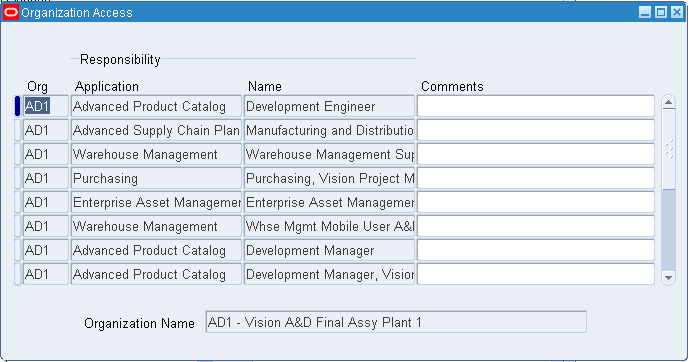
-
Enter the organization code for the organization to which you are restricting access.
-
Enter the application assigned to the responsibility when it was defined.
-
Enter the name of the responsibility you are mapping to the organization entered in the Org field. You must enter an application before entering a responsibility.
The combination of organization, application, and responsibility determines the access mapping. Each combination must be unique.
-
Save your work.
Related Topics
Overview of Inventory Structure
Defining Shortage Parameters
You can enable the system to send material shortage alerts and shortage notifications when a material shortage occurs in an organization. A material shortage occurs whenever unsatisfied demand exceeds available quantity for incoming supply of material. See Material Shortage Alerts and Shortage Notifications.
To define shortage parameters:
-
Navigate to the Shortage Parameters window.
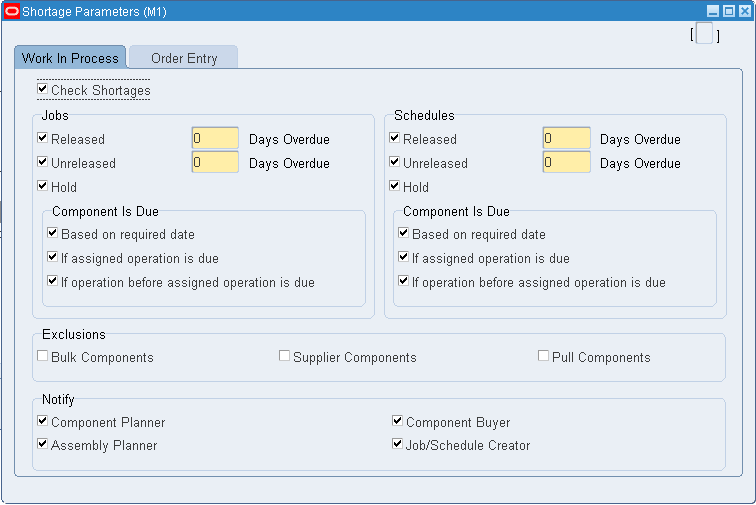
-
In the Work In Process tabbed region, select shortage parameters to configure what is considered as demand.
Check Shortages: Indicates that the material shortage check is enabled for WIP.
Jobs and Schedules regions:
Released: Indicates that all jobs/schedules with status Released, whose scheduled start date is overdue, are included in the material shortage check. This parameter is separately controlled for jobs and schedules.
Unreleased: Indicates that all jobs/schedules with status Unreleased, whose scheduled start date is overdue, are included in the material shortage check. This parameter is separately controlled for jobs and schedules.
Days Overdue: Indicates how many days can go by after the jobs/schedules start date until jobs/schedules with status Released or Unreleased are included in the material shortage check. This parameter functions only if you checked Released or Unreleased. This parameter is separately controlled for jobs and schedules.
Hold: Indicates that all jobs/schedules with status Hold are included in the material shortage check. This parameter can be separately controlled for jobs and schedules.
Component Is Due subregions:
Based on required date: Indicates that the required date specified for each component will be used to determine whether the open requirement is late. This parameter is separately controlled for jobs and schedules.
If assigned operation is due: Indicates that all discrete jobs or repetitive schedules with a current operation that has assigned open material requirements are included in the material shortage check. This parameter can be separately controlled for jobs and schedules.
If operation before assigned operation is due: Indicates that all discrete jobs or repetitive schedules with a current operation before an operation that has assigned open material requirements are included in the material shortage check. This parameter is separately controlled for jobs and schedules.
Exclusions region:
The shortage check looks at the supply type of components on the job or schedule. The supply type may be Based on Bill or manually overridden when jobs or schedules are created.
Bulk Components: Indicates that components with supply type Bulk will be excluded in the material shortage check.
Supplier Components: Indicates that components supplied by vendor will be excluded in the material shortage check.
Pull Components: Indicates that pull components will be excluded in the material shortage check.
Notify region: Select who will receive a workflow notification about the material shortage.
Component Planner: The user name assigned to the item attribute Planner for the component item will be notified. See Defining Planners, Oracle Master Scheduling / MRP and Oracle Supply Chain Planning User's Guide.
Assembly Planner: The user name assigned to the item attribute Planner for the assembly item will be notified.
Component Buyer: The user name assigned to the item attribute Default Buyer for the component item will be notified. See Defining Buyers, Oracle Purchasing User's Guide.
Job/Schedule Creator: The user name of the job/schedule creator will be notified.
-
Select the Order Management tabbed region.
-
Select Order Management shortage parameters.
Check Shortages: A sales order is considered overdue when the pick wave move order is unfulfilled.
Note: A pick wave move order can exist if no available/on-hand quantity exists at pick release, or if the pick wave move order is pick confirmed short or backordered at ship confirm.
Item Planner: The user name assigned to the item attribute Planner for the item will be notified.
Order Creator: The user name of the order creator will be notified.
-
Save your work.
Related Topics
Material Shortage Alerts and Shortage Notifications
Copying Inventory Organizations
You can create and update a large set of inventory organizations and their business entities, such as Subinventories, Items, Bills of material, and Resources. These entities can be copied and customized as part of an inventory organization copy. This aids in the management of inventory organizational setup, which is mandatory for the use of Inventory, Costing, Bills of Material and Work in Process. This feature is useful for companies that have a large number of inventory organizations.
You can copy a source inventory organization's parameters, defaults, and settings, in a single operation, to as many new organizations as you wish for the following setup entities:
-
Bills of Material
-
Routings
-
Items
-
Categories
-
Subinventories
-
Shipping Networks
-
Inventory Parameters
-
WIP Parameters
-
BOM Parameters
Organization Mass Copy is a two-step process. In order to copy source inventory organization structures, you must first set up entity APIs to load interface tables and then run the Copy Organization concurrent program to export and import the setup data.
Prerequisites
-
Define an inventory organization. See: Creating an Organization, Oracle Human Resource Management Systems User's Guide
-
Define organization parameters. See: Define Organization Parameters
Load interface tables
Populate the Copy Organization Interface table with XML data to customize your new Inventory Organizations. You should create an XML document with the minimum organization specific information for each new entity you wish to create.
-
Navigate to the Organization Copy Interface program. On the Find Interface Records form, select New.
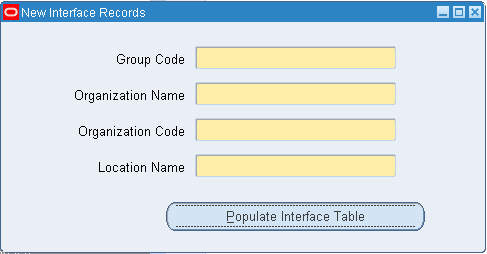
-
Indicate the organization name, organization code, and a valid location for each new organization. You can enter any optional information to override data belonging to the source inventory organization.
Note: If you want to use a new location, provide the required address information in order to define and associate the location with the new organization.
The following table presents example information of what you might load into the interface tables.
Organization Name Organization Code Location Retail Outlet 40001 R01 Harrisburg Retail Outlet 40002 R02 Burlington Retail Outlet 40003 R03 Framingham -
Save the document as an XML file and place in the Copy Organization Interface Tables.
Copy Organizations
A Java Loader program calls Business Entity APIs to perform the mass copy by copying through the XML interfaces and using data from the interface tables.
-
Use the Setup Reports or Submit Requests window and enter Copy Inventory Organization in the Name field to submit the report.
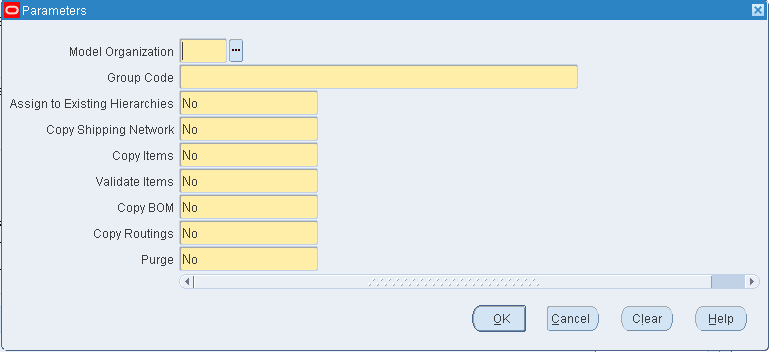
-
Enter the following parameters:
-
Model Organization:
Enter the source inventory organization for the copying procedure.
-
Group Code:
Enter the batch name that refers to the XML document created for loading.
-
Assign to Existing Hierarchies:
No Do not place this organization in every organization hierarchy where the model organization is present. Yes Place this organization in every organization hierarchy where the model organization is present. -
Copy Shipping Network:
No Do not copy shipping network information. Yes Copy shipping network information. -
Copy Items:
No Do not copy all items activated in the model organization. Yes Copy all items activated in the model organization. -
Copy BOM:
No Do not copy BOMs and BOM parameters. Yes Copy all BOMs, BOM parameters and related setups. -
Copy Routings:
No Do not copy routing setup information from the model organization. Yes Copy routing setup information from the model organization. -
Purge:
No Do not purge Copy Organization Interface Tables. Yes Purge Copy Organization Interface Tables.
-
Related Topics
Creating an Organization, Oracle Human Resource Management Systems User's Guide
Creating Organization Hierarchies, Oracle Human Resource Management Systems User's Guide
Defining a New Inventory Organization, Copy Inventory Organization Implementation Guide
Inter-Organization Shipping Network
Use the Inter-Organization Shipping Network window to define accounting information and the relationships that exist between shipping and destination organizations. You can specify whether an organization is a shipping organization, a destination organization, or both.
For each organization relationship you create, you must indicate what type of shipment is used. If you choose to use intransit inventory, Oracle Inventory moves material to intransit inventory before it reaches the destination organization when you perform an inter-organization transfer. Typically, you transfer material through intransit inventory when transportation time is significant. If you do not choose intransit inventory, Oracle Inventory moves your material directly to the destination organization when you perform an inter-organization transfer. You must also specify whether internal orders are required from the destination organization to perform inter-organization transfers. Oracle Inventory does not allow you to perform inter-organization transfers using the Transfer Between Organizations window to an organization that requires internal requisitions. See Overview of Internal Requisitions, Oracle Purchasing User's Guide.
If you choose to use intransit inventory, you must specify which organization has ownership of the inventory while intransit. You must also specify the primary receiving routing: Standard receipt to a receiving location, standard receipt with inspection, or direct receipt to the final destination.
Regardless of the intransit type, you must define an inter-organization transfer charge type. You can choose to add a predefined percentage of the transaction value, to enter a discrete percentage of the transfer value, to enter a discrete value to add when you perform the inter-organization transfer, or not to add transfer charges at all.
Also, you must provide general ledger accounts to record debits and credits involved in an inter-organization transfer.
Finally, you can optionally define shipping methods in the Ship Method QuickCodes window and then enter lead times for these shipping methods in the Inter-org Shipping Methods window. These lead times are used by MRP. See Defining Bills of Distribution, Oracle Master Scheduling / MRP and Oracle Supply Chain Planning User's Guide.
Oracle Inventory defaults the shipping information you entered in the Organization Parameters window when you create new organization relationships in the Inter-Organization Shipping Network window.
Inter-organization shipping network information describes the relationships and accounting information that exists between a shipping (from) organization that ships inventory to a destination (to) organization.
Depending on the function security assigned to your responsibility, you can define a shipping network between the current organization and another organization or between any two organizations. The function security assigned to your responsibility determines whether you have the ability to define shipping networks for all organizations or just the current organization. See Overview of Function Security, Oracle Applications System Administrator's Guide.
Chargeable Subcontracting
Chargeable Subcontracting is a consignment of components by an original equipment maker to a manufacturing partner or trading partner. You can use chargeable subcontracting is support only for Japan, Taiwan, and Korea. When an original equipment manufacturer ships consigned material to a manufacturing partner, the original equipment manufacturer treats the transaction as if the consigned materials are sold. When the original equipment manufacturer receives an assembly item, or out-sourced service from the manufacturing partner, the original equipment manufacturer considers the receipt as a return from consigned. For more information about Chargeable Subcontracting, see the Chargeable Subcontracting Process guide.
To define shipping network basic information
-
Navigate to the Shipping Networks window.
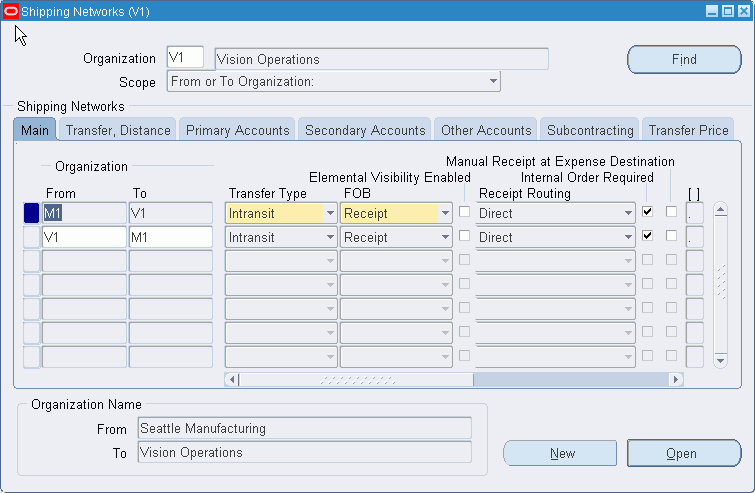
-
Determine if the organization displayed is the To Organization, From Organization, or the From or To Organization.
Note: If your function security allows multiple organization access, you can enter any organization. Otherwise, the Organization field is display only.
-
To define a new shipping network for the current organization choose New Record from the Edit menu. To enter a new record in a single-row window choose the New button.
To find existing shipping network information for the current organization choose Find.
-
Select the Main tabbed region.
-
Enter the shipping or From organization.
-
Enter the destination or To organization.
-
Direct: Inter-organization transfers move inventory directly from the shipping organization to the destination organization.
Intransit: Inter-organization transfers move inventory to intransit inventory first. You can track this inventory until it arrives at the destination organization.
-
If you selected Intransit in the Transfer Type field, select the FOB terms:
Receipt: The shipping organization owns the shipment until the destination organization receives it.
Shipment: The destination organization owns the shipment when the from organization ships it (and while the shipment is in transit).
-
If you selected Intransit in the Transfer Type field, select a receipt routing option:
Standard: Receive this item first, then deliver without inspection.
Direct: At receipt, deliver this item directly to its location.
Inspection: Receive this item first, inspect it, then deliver.
-
Indicate whether an internal order is required for each transfer.
-
Save your work.
To define transfer charge information:
-
Select the Transfer, Distance tabbed region.
-
Select the inter-organization transfer charge type for calculating transfer charges:
None: Do not add transfer charges.
Predefined Percent: Automatically add a predefined percent of the transaction value.
Requested Value: Enter a discrete value to add.
Requested Percent: Enter a discrete percentage of the transfer value to add.
The default value is the value you defined in the Organization Parameters window for the shipping organization. See Defining Organization Parameters.
-
If you selected Predefined Percent in the Transfer Charge Type field, enter the percentage value to add to a material transfer. For example, a value of 10 equals a transaction value of 10%.
The default value is the value you defined in the Organization Parameters window for the shipping organization. See Defining Organization Parameters.
-
Optionally, you can define the following:
-
Enter the unit of measure for the distance from the shipping organization to the destination organization.
-
Enter the distance value (in the unit of measure) from the shipping organization to the destination organization.
-
To define account information
-
Select the Primary Accounts tabbed region.
-
Enter the general ledger transfer credit account used to collect transfer charges for the shipping organization
The default value is the value you defined in the Organization Parameters window for the shipping organization. See Defining Organization Parameters.
-
Enter the general ledger account used to collect the purchase price variance for inter-organization receipts into standard cost organizations. You must enter an account if your receiving organization is using standard costing.
To enter additional account information
-
Select the Secondary Accounts tabbed region.
Note: The default values for the following fields are the values you defined in the Organization Parameters window for the shipping and destination organizations. See Defining Organization Parameters.
-
Enter the general ledger receivables account used as an inter-organization clearing account for the shipping organization. The inter-organization receivable account for the shipping organization should equal the inter-organization payables account for the receiving organization.
-
Enter the general ledger payables account used as an inter-organization clearing account for the receiving organization. The inter-organization receivable account for the shipping organization should equal the inter-organization payables account for the receiving organization.
To enter intransit account information
-
Select the Intransit Account tabbed region.
-
Enter the general ledger account used to hold the intransit inventory value.
To enter intransit lead time for shipping methods:
-
Select Shipping Methods on the Tools menu to open the Inter-org Shipping Methods window.
-
Enter the shipping method for which you want to associate an intransit lead time for the displayed from and to organizations. See Defining Shipping Methods.
-
Enter the intransit lead time in days.
-
Save your work.
To add Subcontracting information
-
Select the Subcontracting tab.
-
Select a Subcontracting Type to enable a subcontracting relationship for this shipping network:
-
Null
-
Buy/Sell
Note: Selling components and buying assembly items are independent business transactions in buy/sell subcontracting.
-
Chargeable
-
-
Enter the Variance account.
-
Enter the Offset account. The manufacturing partner organization uses this account.
-
Enter the default order type. You can enter the default order type only if you enable Chargeable Subcontracting. This field determines the Order Management Order type that is used for Replenishment Sales Order for Chargeable Subcontracting components.
-
Save your work.
Related Topics
Defining Freight Carriers, Oracle Order Management Implementation Guide
Defining Sourcing Rules, Oracle Master Scheduling / MRP and Oracle Supply Chain Planning User's Guide
Defining Shipping Methods
The Shipping Method is a QuickCode used to define specific shipping methods. For example: Ground, Express, or Air. You can associate shipping methods with lead times in the Inter-org Shipping Methods window. See: Defining Inter-organization Shipping Networks.
To define shipping methods
-
Navigate to the Ship Method QuickCodes window from the menu. The User access level is selected indicating you can add or modify QuickCodes without restriction.
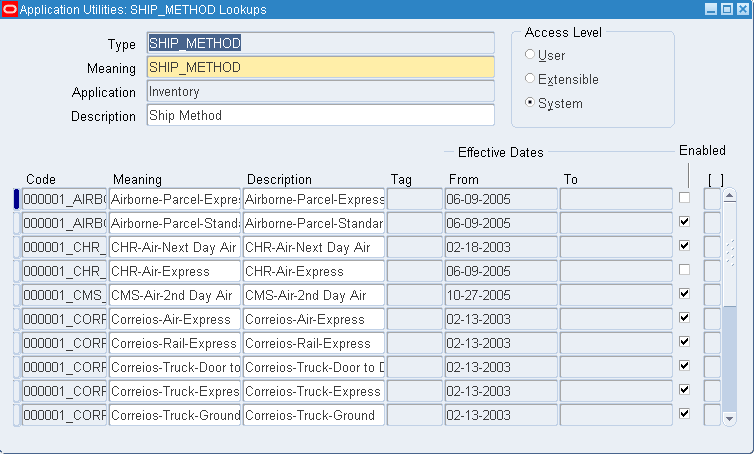
-
Enter a unique alphanumeric code describing the shipping method. You can define a maximum of 250 QuickCodes for a single QuickCode type. Inventory uses this value in the list of values for the Shipping Method field in the Inter-org Shipping Methods window. See: Defining Inter-organization Shipping Networks.
You cannot change the values in this field after saving them. To remove an obsolete QuickCode you can either disable the code, enter an end date, or change the meaning and description to match a replacement code.
-
Enter the meaning of the shipping method code.
-
Optionally, enter from and to effective dates.
If you enter an Effective From date you cannot use the shipping method before this date. If you leave this field blank, the shipping method is valid immediately.
If you enter an Effective To date you cannot use the shipping method after this date. Once a shipping method expires, you cannot define shipping networks using the shipping method, but can query networks that already use the shipping method. If you do not enter an end date, the shipping method is valid indefinitely.
-
Indicate whether the shipping method is enabled. A shipping method must be enabled before you can define shipping networks using it. If you disable a shipping method you cannot use it in shipping networks, but you can query networks that already use the shipping method.
-
Save your work.
Related Topics
Defining Inter-organization Shipping Networks
QuickCodes, Oracle Applications User's Guide
Defining Intercompany Relations
Use the Intercompany Relations window to define, query, and update intercompany relations between two operating units in a multi-organization environment. These relationships are between either a shipping organization and a selling organization, or a receiving organization and a purchasing organization.
When you enter a sales order in an operating unit, the shipping organization is often part of a different operating unit, that has a separate ledger. Once the sales order is shipped to the customer, the inventory asset account for the shipping organization is credited and the cost of goods sold account is debited. Sales revenue must also be recognized in the sales organization. If the two organizations belong to different operating units, then the system must perform accounting distributions to record the intercompany revenue, receivable, and payable entries.
Oracle Inventory and Oracle Receivables must be installed before you can define intercompany relations. If Oracle Payables is not installed, then the system does not require you to enter information in the AP Invoicing for Selling region.
To define intercompany relations
-
Navigate to the Intercompany Relations window. You access the Intercompany Relations window from the Transactions Flow window. The shipping operating unit and the selling operating unit are populated automatically.

-
Enter either the customer name or customer number. When you enter one, Oracle Inventory displays the other automatically. See Creating a Customer, Oracle Receivables User's Guide. A customer is defined in Oracle Receivables to represent the shipping operating unit for AR accounting transactions. If the flow type is shipping, this information is provided automatically. If the flow type is procurement, you must enter this information.
-
Enter the location, if the customer has multiple locations. The list of values displays only locations that are defined for the customer for which Site Use is set to Bill To.
-
Enter the transaction type. See Transaction Types, Oracle Receivables User's Guide for more information.
-
Enter the Intercompany COGS Account. See Intercompany Invoicing Process Overview.
-
Optionally, select the currency code. The available choices are:
-
Currency Code of From Operating Unit
-
Currency Code of To Operating Unit
-
Currency Code of Order
-
-
Enter the supplier and, if available, the supplier site. .
-
Enter the freight account. The list of values is restricted to the Chart of Accounts of the selling organization.
-
Enter the Inventory Accrual account. This account is used for all logical transactions that result from the intercompany transaction such as drop ship.
-
Enter the Expense Accrual account.
-
Save your work.
To update intercompany relations
-
Navigate to the Intercompany Relations window.
-
Query on the desired operating unit in the Shipping field to display the existing relations for that unit.
-
You can update information in all fields except Shipping.
-
Save your work.
Related Topics
Intercompany Invoicing Process
Defining Economic Zones
The Economic Zones window supports Oracle Inventory movement statistics functionality for gathering, reviewing, and reporting statistical information associated with material movements. You automate the movement statistics functionality by defining parameters in the Economic Zones and Movement Statistics Parameters windows. See: Overview of Movement Statistics and Defining Movement Statistics Parameters.
Use the Economic Zones window to define the economic zones in which you conduct business. Oracle Inventory uses this information to determine which material movement transactions take place in a reporting jurisdiction.
To define an economic zone
-
Navigate to the Economic Zones window.
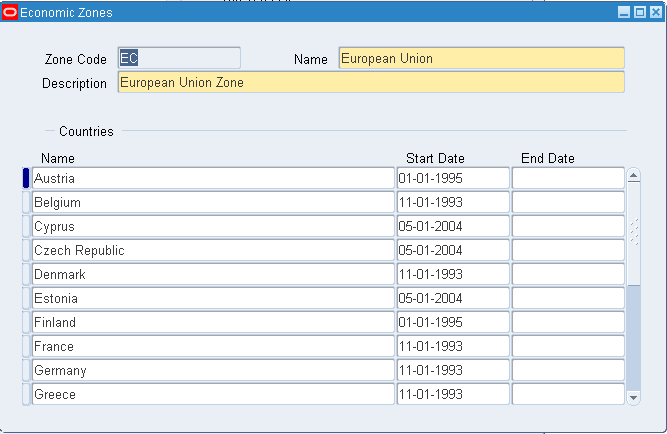
-
Enter a zone code.
Note: The European Union is seeded in the system as an economic zone. You can update countries in the European Union common market by selecting the country code from the list of values.
-
Enter a name for the economic zone.
-
Enter a description of the economic zone.
-
Enter the countries you want to associate with this economic zone in the Name field of the Countries region.
You can associate a country with more than one economic zone.
-
Enter a start date for each country.
-
Enter an end date for each country.
-
Save your work.
To update an economic zone
-
Navigate to the Economic Zones window.
-
Navigate to the Find Zones window by selecting Find from the View menu.
-
You can update information in all fields.
-
Save your work.
Related Topics
